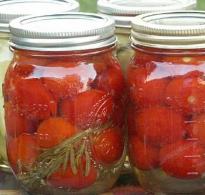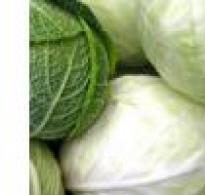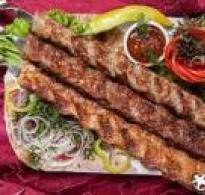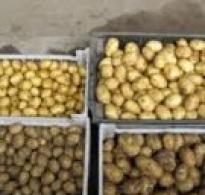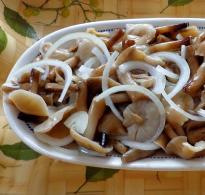How to make Japanese bento at home. Bento: Japanese lunch box
To be honest, I was going to put together a bento for the post - a Japanese lunch to go - from simple products that are available on any continent, without Asian specifics, but to be beautiful. But she suffered a shameful defeat in front of herself)) I occasionally collect boxes for a child in kindergarten or when we are going somewhere far, but I do not know how to make bento according to all the rules. Moreover, I actively dislike decorations and attempts to sculpt food out of food that is not food, I just fundamentally disagree with it.
There are special editions in Japan dedicated to harmonious and interesting bento, and there are always tips in household and cooking magazines on how to change the architecture of a set for variety. Modern bentos don't have to be cute and childish, faces and flags are mostly just for toddlers. Of course, I would like to see the family in which it is customary to cook and take such beauty with them.
Bento culture in Japan is very developed - you can buy a box with a ready-made lunch at any store or stall, order fresh or frozen delivery, buy an exclusive local bento at the station, or from a restaurant chef. Many people dine at work with what they brought from home - it is cheaper and more practical, and the hostess gets up early and collects everyone who leaves in the morning and comes in the evening. A distinctive feature of bento is just a little: a spoonful of one snack, a piece of another ... The components are usually ready in advance and stored in the refrigerator, they just need to be put together in time and harmoniously. They put what they like in bento, it can be a plate of spaghetti or a sandwich, but there are some general rules.
1. Classic proportions: this is in such a volume of rice, next to the protein component (meat, fish, chicken), then vegetables.

2. Do not put components while hot. Combine them so that you can eat everything at room temperature, or evenly warmed up.
3. Food should not be wet, not greasy and keep its shape well. Everything needs to be cut into pieces that can be conveniently picked up with chopsticks or a fork, for one bite.
4. Hygiene! Clean hands, disinfected dishes, if it's summer, Japanese women cover bento bags with dry ice or frozen gel.
5. Classic Japanese bento should be harmonious in color. If not all the colors of the rainbow should be present in it)) then exactly a combination of the main

Interestingly, the redesign of the bento is already perceived by the Japanese as a "new bento" even if the food is the same.



Special Instagram bento :)))

Layout options for 1 and 4 people


They write that it is very easy to do. Ha ha!



Sandwich Ideas: Dessert Bread with Cocoa, Fresh Figs, Whipped Cream. Or three salads: beetroot with coconut, pickled peppers, green kale with ricotta, white - cream cheese and sugar-free yogurt.

These grape buters hurt me in the very heart)) True, this is not practical at all, and doubtfully tasty.


Bento (Japanese 弁 当 bento) is a Japanese term for a one-portion packaged meal. Traditionally, bento consists of rice, fish, or meat and one or more chopped raw or pickled vegetables in a single box with a lid. Boxes can be different in shape and manufacturing method - from simple, mass-produced, to piece-made containers, made of rare wood, lacquered, which are real works of art.
To put it simply, this is food that is beautifully laid out and packed in a beautiful box, which is very convenient to take with you. Like everything Japanese, this is a very peculiar area of, I'm not afraid of this word, art, since some bento look like they are works of art. In Japan, they are sold ready-made and packaged in stores. And every housewife considers it her duty to learn how to make bento.
But bento can be more than just traditional. The West, as always, takes the best and most interesting from the East and Asia and alters it a little in its own way. We can also add our bento to work as lunch or to school for children, in which instead of rice and fish there will be pancakes with cottage cheese or Kiev cutlets. It doesn't matter what you decide to make your lunch from, the main thing is that it conforms to the 5 main rules of bento. How can this be useful to us? Well, first of all, it makes the food look prettier, and therefore more appetizing. Secondly, in one such bento you can organically pack several tasty and healthy dishes, instead of one. And thirdly, it is a very good idea for treats for children at a party or for picnic trips with large companies.
Some bentos look like this:
In the same post, we will talk about simpler and very tasty options. For example, these are:

So, there are 5 basic rules for making a bento for every day:
- The food should be delicious. The simplest and one of the most important rules.
- Healthy and nutritious. You can eat sweets and other junk food at any time of the day, but lunch should be tasty, healthy and nutritious because that is our fuel for the rest of the day. This is the second main rule!
- Neat and appetizing in appearance. One of the fundamental tenets of bento, like all Japanese cuisine, is that the look of the food is as important as the taste.
- Simple and quick to prepare. Because you already spend too much time on everything else. Even for those who love to cook, the daily hours at the stove and the production of culinary masterpieces take too much time and effort. And the process is not a joy, and the result. Therefore, for creativity, set aside one day off for yourself, and for work days, leave simplicity and functionality. Build your meals with simple, healthy, and delicious ingredients.
- Food doesn't have to be expensive. Making takeout meals at home is a great way to save money. Since even if it seems to you that the cost of a business lunch is very cheap, it can be a good option several times. But even the cheapest set menu will end up costing you a pretty penny in a month. And I already said that it is much more useful than any business lunch?
And one more rule of bento - everything that you pack must be eaten within a few hours. That is, if you brought lunch with you, you should eat it at lunch, and not at 16:00 for tea. Therefore, you must prepare your own lunch with foods that either do not go bad at room temperature, or they can be eaten cold and the overall dish will not lose its taste from this.
Great for picnics:
- Proteins that stay tasty and safe at room temperature. Hard boiled eggs, fried or boiled chicken, deli meats (ham, ham, etc.)
- Steamed, chilled or raw vegetables that won't wilt (carrots, asparagus, cucumbers, tomatoes, broccoli, etc.).
- Carbohydrates that remain tasty and safe at room temperature. This can be bread, cooked and well-packed rice, or other grains. Pasta with non-mayonnaise-based sauces or dressings.
- Dry foods. Nuts, dried fruits, seeds, crackers, or crispbread.
- Canned food. For example, jam or pickles.
If you are packing your lunch for work, you can safely take with you in separate containers what you can and even need to eat chilled. For example, tuna salad or vegetable salad. And also, since we are not in Japan and do not have to follow all the rules, you can take with you something that you can warm up. Of course, if you have a microwave at work. The soup can be brought separately, and the second can be beautifully packaged in a container.
How to make a bento for every day?
Start by writing a list of your favorite foods and foods that you would like to eat every day. Then divide the sheet into 5 columns: protein, carbohydrates, combined foods, vegetables, fruits, and sweets. And write in each of the columns at least 3-4 dishes or individual products in each category.
After that, make yourself lunches from the selected products for several days in advance. The finishing touch is to choose a convenient and spacious box for your meals. In addition to the standard shape, you can use small silicone muffin tins to prevent one dish from mixing with the rest. For example, you can put tzatziki or hummus in there, or something else that you would not like to mix with the main course.
Bento examples
Bento # 1

Collect sandwiches with your favorite ingredients and add fresh vegetables to the box!
Bento # 2

Ingredients: boiled ham, cheese, grapes, prosciutto, whole grain bread and a mix of herbs.
Bento # 3

Stewed cabbage with baked potatoes, herbs and a piece of hard cheese in the shape of an angel. And it's even better and faster not to stew the cabbage, but to take the Brussels sprouts (it's more convenient this way), cut in half and coat with olive oil. Put it on a baking sheet and send to bake or grill. As a result, it turns out to be more delicious, less fiddling with it, it keeps well in the refrigerator and is very tasty even when cold. I think you know how to bake potatoes. It is also not necessary to dodge this way with cheese, but if you like, you can use any aluminum cookie cutters.
Bento # 4

Boiled rice, asparagus, green peas, scrambled eggs, lightly salted salmon and tomatoes. You can add a few drops of wine vinegar to the asparagus for flavor.
Bento # 5

This bento contains broccoli pieces (in boiling salted water for two to three minutes), fried dumplings (ravioli are fried in the original), fennel (can be replaced with any other favorite vegetable or root vegetable) and meatballs. I think that simply fried pieces of meat or poultry will work too.
Good appetite!
Bento is a Japanese version of a packed lunch that is often taken with you to work, school, or just on the road. As a rule, this type of food is divided into two parts: half of the whole package is rice, and the second part is protein products (fish, meat, eggs) and vegetables. But it also happens that bento from a simple dinner becomes a real work of art.
Bento is the Japanese definition for a fabricated one-serving meal.


Often the ingredients for bento are used in the following proportions: 4: 3: 2: 1 parts. That is, 4 parts includes rice, 3 parts of meat or fish, 2 parts of vegetables, and the rest of pickled vegetables or dessert.



It also happens that chefs create bento in figures of people, famous characters from movies, animals, as well as from various forms - flowers, plants, trees, leaves.



Bento packaging can also vary - sometimes it is a primitive plastic box from a supermarket, and sometimes it is a work of art, carved from wood and covered with shiny varnish.

There are several different types of bento:
Bento bale- when Chinese food is used.

Kamameshi bento- Sold at train stations in Nagano Prefecture. Packaged in a pot of their clay and warmed up. The clay pot is often left as a souvenir.

Makuno-uchi bento- a classic consisting of rice, pickled plums, a piece of fried fish and a hard-boiled egg.
Noriben- the most common bento with rice and nori.

Sake bento- rice and fish are used, most often a piece of salmon


Shidashi bento- sold in restaurants on request. This bento is often eaten at an event such as a funeral, party, or wedding. Usually includes traditional Japanese food such as tempura, rice, and pickled vegetables.
Jukuben- bento, which is put in school for children.


Sushizume is a wrapped bento sushi.

Hayaben can be eaten quickly before or after lunch, in fact, it is an afternoon snack.

Hinomaru bento- this composition symbolizes the Japanese flag - Hinomaru - from which the bento got its name. Consists of rice and one pickled plum.


Karaben- bento made in the form of men or animals.




What is the difference between bento and our boutiques? The fact that it is a well-chosen and balanced meal, and even allowing you to show your individuality - that is, the complete opposite of a unified fast food. The very best bentos are, of course, those made at home by loving wives and mothers. The Japanese say, "Show me your bento, and I'll tell you what kind of wife you have." Of course, with the help of bento, husbands can show off their wife's talents to colleagues, but the main field of activity of a Japanese woman is bento for children. This is where mothers try to surpass others and themselves!
But bento can be more than just traditional. The West, as always, takes the best and most interesting from the East and Asia and alters it a little in its own way. How can this be useful to us? Well, first of all, it makes the food look prettier, and therefore more appetizing. Secondly, in one such bento you can organically pack several tasty and healthy dishes, instead of one. And thirdly, it is a very good idea for treats for children at a party or for picnic trips with large companies. Classic bento consists of rice, fish or meat and a side dish of pickled or fried vegetables.
When preparing bento, the Japanese consider it important to maintain a 4: 3: 2: 1 ratio. This means 4 parts rice, 3 parts garnish, 2 parts fried or raw vegetables, and 1 part pickled vegetables or dessert. However, today all sorts of deviations from the classical canons are allowed. Craftsmen are ready to use new products and unusual combinations, giving the traditional meal an extremely attractive look. A beautifully designed box is especially delightful for children.
By the way, bento boxes can also be different - in one case it is a simple plastic box, made in a factory way and bought in a supermarket, and in the other - a real work of art made of wood and varnished. The homemade bento is wrapped over the top of the box in a traditional furoshiki shawl that, when unrolled, turns into a mini tablecloth - steles, wherever, and eat homemade food!
A real Japanese hostess always prepares bento for her family and friends herself, therefore the misstatement of the components for bento and their serving are one of the signs of a good wife / mother, and besides, this way you can once again express your love and care for the most dear people.
 |
For the first time in Japanese history, "bento" appears in the Kamakura period (1185-1333), when cooked and then dried rice "Hoshi-i" (hoshi-i, or literally - "dried food") becomes widespread. Such a rice-force with you in a small purse and on occasion it could be thrown into boiling water, thus obtaining boiled rice, or eaten right like that, if it was already completely unbearable. Later, in the Azuchi-Momoyama period (1568-1600), the first bento boxes appeared, which, in principle, did not change much over the centuries, and now bento began to be eaten on Hanami or with a bite of tea.
If you want both you and your loved ones to look forward to dinner, try to cook something special - let the ingredients be quite simple, but with skillful serving, the simplest dish becomes a work of art. And if it is done with a soul Start with a simple bento and move on to more complex options gradually. If you try to do something difficult on the first try, then you may be disappointed, because it is unlikely that you will be able to master this art the first time. Take time to prepare bento.
Remember, there is no rush here, and the time and effort involved make bento so special and delicious. To add spice to rice, you can use homemade spice sets (furikake) or buy ready-made ones in any of the eastern markets. Using spices on rice, you can lay out a pattern, for example, a heart. If you use ready-made stencils, then you can lay out something more complex.Bento (Japanese 弁 当 bento) is a Japanese term for a one-portion packaged meal. Traditionally, bento consists of rice, fish, or meat and one or more chopped raw or pickled vegetables in a single box with a lid. Boxes can be different in shape and manufacturing method - from simple, mass-produced, to piece-made containers, made of rare wood, lacquered, which are real works of art.
To put it simply, this is food that is beautifully laid out and packed in a beautiful box, which is very convenient to take with you. Like everything Japanese, this is a very peculiar area of, I'm not afraid of this word, art, since some bento look like they are works of art. In Japan, they are sold ready-made and packaged in stores. And every housewife considers it her duty to learn how to make bento.
But bento can be more than just traditional. The West, as always, takes the best and most interesting from the East and Asia and alters it a little in its own way. We can also add our bento to work as lunch or to school for children, in which instead of rice and fish there will be pancakes with cottage cheese or Kiev cutlets. It doesn't matter what you decide to make your lunch from, the main thing is that it conforms to the 5 main rules of bento. How can this be useful to us? Well, first of all, it makes the food look prettier, and therefore more appetizing. Secondly, in one such bento you can organically pack several tasty and healthy dishes, instead of one. And thirdly, it is a very good idea for treats for children at a party or for picnic trips with large companies.
Some bentos look like this:
In the same post, we will talk about simpler and very tasty options. For example, these are:

So, there are 5 basic rules for making a bento for every day:
- The food should be delicious. The simplest and one of the most important rules.
- Healthy and nutritious. You can eat sweets and other junk food at any time of the day, but lunch should be tasty, healthy and nutritious because that is our fuel for the rest of the day. This is the second main rule!
- Neat and appetizing in appearance. One of the fundamental tenets of bento, like all Japanese cuisine, is that the look of the food is as important as the taste.
- Simple and quick to prepare. Because you already spend too much time on everything else. Even for those who love to cook, the daily hours at the stove and the production of culinary masterpieces take too much time and effort. And the process is not a joy, and the result. Therefore, for creativity, set aside one day off for yourself, and for work days, leave simplicity and functionality. Build your meals with simple, healthy, and delicious ingredients.
- Food doesn't have to be expensive. Making takeout meals at home is a great way to save money. Since even if it seems to you that the cost of a business lunch is very cheap, it can be a good option several times. But even the cheapest set menu will end up costing you a pretty penny in a month. And I already said that it is much more useful than any business lunch?
And one more rule of bento - everything that you pack must be eaten within a few hours. That is, if you brought lunch with you, you should eat it at lunch, and not at 16:00 for tea. Therefore, you must prepare your own lunch with foods that either do not go bad at room temperature, or they can be eaten cold and the overall dish will not lose its taste from this.
Great for picnics:
- Proteins that stay tasty and safe at room temperature. Hard boiled eggs, fried or boiled chicken, deli meats (ham, ham, etc.)
- Steamed, chilled or raw vegetables that won't wilt (carrots, asparagus, cucumbers, tomatoes, broccoli, etc.).
- Carbohydrates that remain tasty and safe at room temperature. This can be bread, cooked and well-packed rice, or other grains. Pasta with non-mayonnaise-based sauces or dressings.
- Dry foods. Nuts, dried fruits, seeds, crackers, or crispbread.
- Canned food. For example, jam or pickles.
If you are packing your lunch for work, you can safely take with you in separate containers what you can and even need to eat chilled. For example, tuna salad or vegetable salad. And also, since we are not in Japan and do not have to follow all the rules, you can take with you something that you can warm up. Of course, if you have a microwave at work. The soup can be brought separately, and the second can be beautifully packaged in a container.
How to make a bento for every day?
Start by writing a list of your favorite foods and foods that you would like to eat every day. Then divide the sheet into 5 columns: protein, carbohydrates, combined foods, vegetables, fruits, and sweets. And write in each of the columns at least 3-4 dishes or individual products in each category.
After that, make yourself lunches from the selected products for several days in advance. The finishing touch is to choose a convenient and spacious box for your meals. In addition to the standard shape, you can use small silicone muffin tins to prevent one dish from mixing with the rest. For example, you can put tzatziki or hummus in there, or something else that you would not like to mix with the main course.
Bento examples
Bento # 1

Collect sandwiches with your favorite ingredients and add fresh vegetables to the box!
Bento # 2

Ingredients: boiled ham, cheese, grapes, prosciutto, whole grain bread and a mix of herbs.
Bento # 3

Stewed cabbage with baked potatoes, herbs and a piece of hard cheese in the shape of an angel. And it's even better and faster not to stew the cabbage, but to take the Brussels sprouts (it's more convenient this way), cut in half and coat with olive oil. Put it on a baking sheet and send to bake or grill. As a result, it turns out to be more delicious, less fiddling with it, it keeps well in the refrigerator and is very tasty even when cold. I think you know how to bake potatoes. It is also not necessary to dodge this way with cheese, but if you like, you can use any aluminum cookie cutters.
Bento # 4

Boiled rice, asparagus, green peas, scrambled eggs, lightly salted salmon and tomatoes. You can add a few drops of wine vinegar to the asparagus for flavor.
Bento # 5

This bento contains broccoli pieces (in boiling salted water for two to three minutes), fried dumplings (ravioli are fried in the original), fennel (can be replaced with any other favorite vegetable or root vegetable) and meatballs. I think that simply fried pieces of meat or poultry will work too.
Good appetite!

